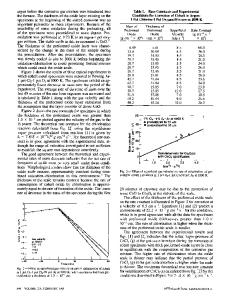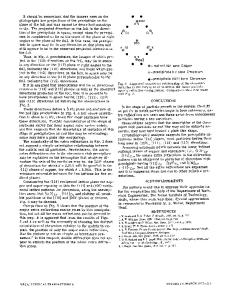Decomposition in Al-Zn alloys: Part I. Isothermal decomposition in an Al-22 at. pct Zn-0.1 at. pct Mg alloy
- PDF / 872,399 Bytes
- 7 Pages / 612 x 792 pts (letter) Page_size
- 91 Downloads / 335 Views
Hilliard.* Unfortunately, they did not report data for *Acuna and Bonfiglioli 's have in effect repeated Rundman and Hilliard's experiment on an Al-15 at. pct Zn alloy aged at -45~ arriving at an estimate o f t which is in agreement with the above workers. However, they interpreted their results as being in better agreement with predictions of the modified theory of Cook and de Fontaine.t r
the time dependence of the integrated intensity, a par a m e t e r which would provide insight into the extent of the spinodal transformation and ascertain whether Gerold and M e r z ' s objections were indeed valid. The integrated intensity about the origin of r e c i p r o c a l space is proportional to the percent completion of the spinodal reaction, and has an isothermal time dependence which should be v e r y similar to a nucleation and growth reaction if the spinodal transformation is completely suppressed during the quench. 16 It should be pointed out that a measurement of the integrated intensity will be meaningful only if there are no competing transformations occurring while the spinodal t r a n s formation is taking place. In the case of the Al-Zn work of Rundman and Hilliard, 1~ there was some concern over the presence of a rapid discontinuous t r a n s f o r m a tion of the matrix to the equilibrium phases by simultaneous nucleation and growth on the grain boundaries. This competing reaction would, of course, make r e l i able integrated intensity measurements characterizing the spinodal product v e r y difficult to obtain. The purpose of this paper is to present new data describing the kinetics of spinodal decomposition in an A1-Zn base alloy aged for long times without competition from the equilibrium phases. We have been able to accomplish this by alloying an A1-22 at. pet Zn alloy with 0.1 at. pet Mg; this addition successfully eliminates the discontinuous reaction, the equilibrium phases f o r m ing after much longer times than in the binary atloy. (Satyanarayana et alta noticed a similar effect in an A130 at. pct Zn-0.35 at. pet Mg alloy.) Consequently, the evolution of the spinodal structure can be followed to much later times than was possible in the binary alloy permitting a careful look at the kinetics of the late stages of decomposition via the small angle scattering technique. It is also our intent to document the apparent effect of Mg on the isothermal changes in the compositional VOLUME 6A, OCTOBER 1 9 7 5 - 1 8 8 7
400,
I
I
I
I
I
300 tD
I# S
o
', \ \ \
1
L
i
till L
200
// / I
o.
E
// / , tI
100
/ o
i i
0
! i
'
:
19
20
30
40
50
60
r a n g e 9.80 to 0.28 deg 20. Counting t i m e s w e r e adj u s t e d to provide, in m o s t i n s t a n c e s , at l e a s t 10,000 counts at each s c a t t e r i n g angle. The g o n i o m e t e r was p r o g r a m m e d by a Harshaw t a p e - c o n t r o l l e d step s c a n ner. After the X - r a y s p e c t r a were g e n e r a t e d for all the s p e c i m e n s , the data was c o r r e c t e d for the i n s t r u m e n tal broadenin
Data Loading...











